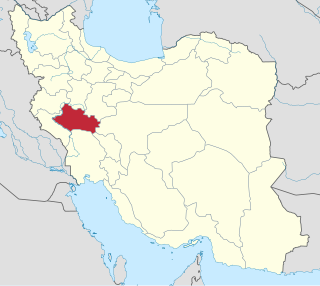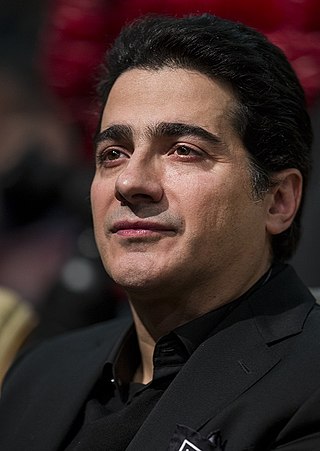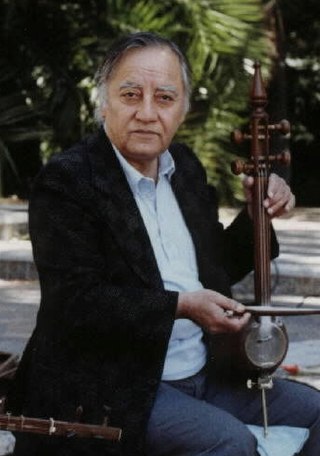Luri music is referred to an ethno-cultural characteristic of Lurs in the Middle East. Luri music enjoys a various and ancient background. [1] [2]
Contents

Luri music is referred to an ethno-cultural characteristic of Lurs in the Middle East. Luri music enjoys a various and ancient background. [1] [2]

The most popular Luri musical instruments include Sorna, Dohol, Tâl (Luri kamancheh), [3] Tonbak (Tomak), and the common Iranian traditional instruments. Meanwhile, the Luri kamancheh is the only one that is fundamentally different from other Iranian music instruments. [4] The Lurs select the Mâhur as their basic musical scale to showcase the magnificence, grandeur and independence of their people. [5]
Persian traditional music or Iranian traditional music, also known as Persian classical music or Iranian classical music, refers to the classical music of Iran. It consists of characteristics developed through the country's classical, medieval, and contemporary eras. It also influenced areas and regions that are considered part of Greater Iran.

Lorestan province is one of the 31 provinces of Iran. Its capital is the city of Khorramabad. It is in the western part of the country in the Zagros Mountains and covers an area of 28,392 km2.

The kamancheh is an Iranian bowed string instrument used in Persian, Azerbaijani, Armenian, Kurdish, Georgian, Turkmen, and Uzbek music with slight variations in the structure of the instrument. The kamancheh is related to the rebab which is the historical ancestor of the kamancheh and the bowed Byzantine lyra. The strings are played with a variable-tension bow.

Hossein Alizadeh is an Iranian musician, composer, radif-preserver, researcher, teacher, and tar, shurangiz and setar instrumentalist and improviser. He has performed with such musicians as Shahram Nazeri, Mohammad-Reza Shajarian, Alireza Eftekhari and Jivan Gasparyan, as well as with a number of orchestras and ensembles.

The tar is a long-necked, waisted lute family instrument, used by many cultures and countries including Iran, Azerbaijan, Uzbekistan, Armenia, Georgia, Tajikistan, Turkey, and others near the Caucasus and Central Asia regions. The older and more complete name of the tār is čahārtār or čārtār, meaning in Persian "four string",. This is in accordance with a practice common in Persian-speaking areas of distinguishing lutes on the basis of the number of strings originally employed. Beside the čārtār, these include the dotār, setār, pančtār, and šaštār or šeštār.

Kayhan Kalhor is an Iranian Kurdish kamancheh and setar player, and a vocal composer. He has received three Grammy Award for Best Traditional World Music Album nominations. Kalhor also has earned two nominations and won one Grammy Award for Best Global Music Album as a member of the Silk Road Ensemble.

The rebab is the name of several related string instruments that independently spread via Islamic trading routes over much of North Africa, Middle East, Central Asia, Southeast Asia, and parts of Europe. The instrument is typically bowed, but is sometimes plucked. It is one of the earliest known bowed instruments, named no later than the 8th century, and is the parent of many bowed and stringed instruments.
Kemenche or Lyra is a name used for various types of stringed bowed musical instruments originating in the Eastern Mediterranean, particularly in Greece, Armenia, Iran, Turkey, and Azerbaijan. and regions adjacent to the Black Sea. These instruments are folk instruments, generally having three strings and played held upright with their tail on the knee of the musician. The name Kemenche derives from the Persian Kamancheh, meaning a "small bow".

Homayoun Shajarian is an Iranian singer. Homayoun is the son of Iranian singer Mohammad-Reza Shajarian, He learned singing from his father and started his musical career in the 1990s.

The Lurs are an Iranian people living in western Iran. The four Luri branches are the Bakhtiari, Mamasani, Kohgiluyeh and Lur proper, who are principally linked by the Luri language.

Hossein Tehrāni was an Iranian musician and tonbak player. He is regarded as an innovator, expanding the modern tonbak into an instrument that can be played solo, in addition to its earlier role as an accompaniment instrument. Tehrāni added to the instrument's possibilities with added "beating methods" and played his instrument with different "sonorities".

Persian musical instruments or Iranian musical instruments can be broadly classified into three categories: classical, Western and folk. Most of Persian musical instruments spread in the former Persian Empires states all over the Middle East, Caucasus, Central Asia and through adaptation, relations, and trade, in Europe and far regions of Asia. In ancient era, the Silk road had an effective role in this distribution.

A sazanda or sazandar is one of the three musicians in the traditional ensemble of instrumentalists performing along with a singer in the South Caucasus. The word means "builder" in Persian. The trio consists of a tarist, a kamanchist and a daf player. Historically the word sazanda(r) was applied to any instrumentalist from Anatolia, the Caucasus or Iran, who played a folk instrument.

The Mastān Ensemble is an Iranian musical group performing traditional Persian music.

Mortezâ Varzi was an Iranian musician.

Shahmirza Moradi was an Iranian Lur especially versed in playing sorna.
Ecomusicology is an area of study that explores the relationships between music or sound, and the natural environment. It is a study which encompasses a variety of academic disciplines including musicology, biology, ecology and anthropology. Ecomusicology combines these disciplines to explore how sound is produced by natural environments and, more broadly how cultural values and concerns about nature are expressed through sonic mediums. Ecomusicology explores the ways that music is composed to replicate natural imagery, as well as how sounds produced within the natural environment are used within musical composition. Ecological studies of sounds produced by animals within their habitat are also considered to be part of the field of ecomusicology. In the 21st century, studies within the field the ecomusicology have also become increasingly interested in the sustainability of music production and performance.

Layli, or Leyli (Luri=لَیلی), also Bahig or Bavig, is a hinged dancing doll, which is popular among Lur people of Iran.
Luri dances include a range of folk dances popular among different groups of Iran's Lur people. They usually include common Iranian dances; Collective dances and quadrille, the circular arrangement, and the colorful clothing.
Mugham trio or mugham triads is a classical ensemble of three Azerbaijani national musical instruments: tar, kamancheh, and qaval performers. It is a traditional musical group of Azerbaijani musicians who perform the mugham repertoire and represent the ensemble of khanandas and sazandas.